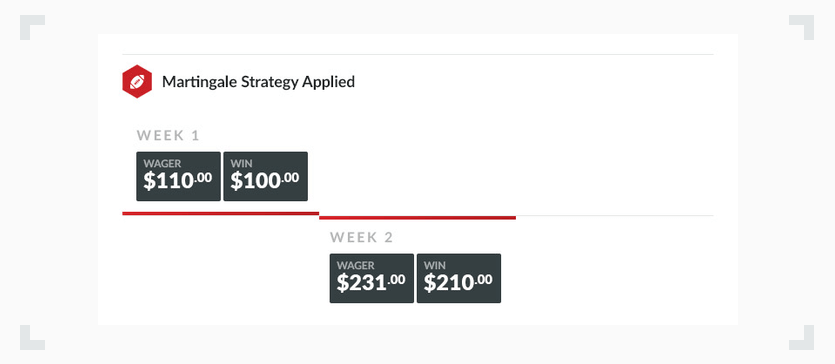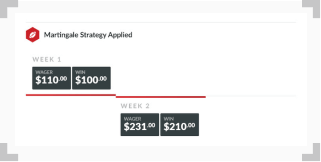The Martingale System: Grow Your Bankroll Formulaically

Whether it’s a lengthy stretch of victories, a dismal run of consecutive outright losses, or regular bad luck at your sportsbook, everyone eventually finds themselves on a streak. And like all good things, every streak is bound to end, which is where martingale sports betting comes in.
While lengthy streaks can leave loyal fans brimming with confidence or reeling in despair, many sports bettors see an opportunity to profit off the inevitable end to the streak.
We’ll introduce you to the martingale system, which is widely-used by strategic sharp bettors looking to find an edge over bookmakers.
What Is the Martingale Sports Betting System?
Using the martingale betting system, a sports bettor places a bet on a specific team and an expected outcome. If the first bet proves to be a loser, the sports bettor increases their stake on each subsequent bet on the same outcome. This continues until a win is achieved.
With each subsequent losing bet, bettors wager double the stake laid on their previous losing bet – and so on – until the desired expected outcome pays out and turns a profit.
The Math Behind the Martingale System
Let’s keep things simple. Say that you’re starting with a bankroll of $11,000 which is subsequently divided into 100 units of $110 each.
We’ll apply the martingale strategy to an NFL bet to cover the spread, with a starting wager of one unit ($110) on the Cleveland Browns. As is standard with NFL spread bets, let’s say that the Brown’s odds against the spread are -110.
In this case, your initial Week 1 wager of $110 (which includes the vig typically paid to the sportsbook) has potential winnings of $100.
In the event your Week 1 bet is a loser, the martingale system dictates that you’ll need to bet again on Cleveland in Week 2. You’ll need to increase the to provide a return equal to both the amount you wagered in Week 1 (plus the amount you would have won if your Week 1 bet had been a winner).
Breakdown of Martingale System for Sports Betting Applied to a Bet on the Cleveland Browns


If your week 1 bet is a loser, your week 2 wager is determined by the size your week 1 wager, plus what you could have potentially won in week 1.
Further, you’ve got to account for the vig, which in this case is $21. As such, your wager would be calculated by adding $110 + $100 + $21, giving you a total of $231.


If your week 2 bet is a loser, the size of your week 3 wager is determined by your week 2 wager plus the what you could have potentially won in week 2. Additionally, you’ve got to account for the vig. As such, your bet would be calculated as follows: $231 + $210 + $43.10 = $474.10. During the NFL season all these betting lines are available to wager on in real time, from Week 1 to the Super Bowl.
You can continue to use the martingale method until you eventually produce a winner.
Limitations of the Martingale System for Betting
Faithfully adhering to the martingale strategy for sports betting will inevitably produce a winning bet. However, the method does have some limitations.
There’s a real possibility of your bankroll running dry before the end of a streak that produces a winning bet. If you managed to pick a winner in Week 3, you’d have wagered a total of $805.
If the streak had dragged on beyond Week 3, you’d quickly find that it would get harder and harder to diversify your betting strategy. Your ability to make wagers on other events would be severely restricted, and eventually, your bankroll would be depleted all together if the streak dragged into Week 7.
While the NFL’s short schedule may make this a reasonable risk when using the martingale system to bet against the spread, lengthy streaks are much more common in sports with long schedules including the NHL, NBA, and MLB.
Since the start of the 2008-2009 season, there have been over 60 outright winning streaks that lasted 10 or more games in the NBA. In addition, the Atlanta Hawks’ epic ATS win streak in January 2015 lasted 13 games and would have required you to bump up your wager on the streak-ending 14th contest to a prohibitive $1,685,987.23 – just to win your desired profit of $100.
Boost Your Bankroll by Doing Your Homework
While the martingale system may offer an irresistible allure for sports bettors looking to cash in on the end of a streak, it’s clearly a strategy that’s limited only to players with big bankrolls and money to burn.
For the rest of us, the fun and profit in sports betting results from adhering to strong fundamental bankroll management, as well as doing the proper research so you can find value and gain an edge at the sportsbooks.

Evergreen Writer/Editor; Sportsbook Expert
With nearly two decades of experience in sports media, Paul Costanzo turned his professional attention to sports betting and online gambling in January of 2022. He's covered every angle of the industry since then, managing and creating content for PlayMichigan and The Sporting News, and now SBD.



